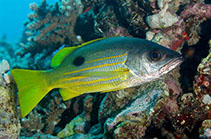| Family: |
Lutjanidae (Snappers), subfamily: Lutjaninae |
| Max. size: |
35 cm TL (male/unsexed) |
| Environment: |
reef-associated; freshwater; brackish; marine; depth range 5 - 20 m |
| Distribution: |
Indo-West Pacific: Red Sea and East Africa to the Solomon and Mariana islands. |
| Diagnosis: |
Dorsal spines (total): 10-10; Dorsal soft rays (total): 13-14; Anal spines: 3-3; Anal soft rays: 7-9. This species is distinguished by the following characters: body moderately deep; greatest depth 2.5-3.0 in SL; preopercular notch and knob poorly developed; vomerine tooth patch triangular, with a medial posterior extension; gill rakers of first gill arch 6-7 + 10-14 - 16-21; caudal fin truncate to slightly emarginate; scale rows on back parallel to lateral line. Colour of back and upper sides dark brown, lower sides and belly whitish with a silver sheen; usually a series of 4-5 narrow yellow stripes on the sides below the lateral line; a distinct round, black spot on the back below the posterior part of the spinous portion of the dorsal fin (Ref. 9821, 90102).
Description: Dorsal profile of head moderately sloped; preorbital bone very narrow, its width about half of eye diameter (Ref. 90102). |
| Biology: |
Adults inhabit very shallow coastal habitats, often in large schools near freshwater run-offs (Ref. 48635). Juveniles often intertidal (Ref. 48635); over sand, silt, or coral rubble bottoms, occasionally in mangrove-lined streams and estuaries (Ref. 9821) They may enter freshwater to feed (Ref. 245); on small fish and invertebrates (Ref. 5213). This is a small species commonly utilized in subsistence fisheries and also seen in markets. Caught mainly with handlines, traps, and gill nets and are marketed mostly fresh (Ref. 9821). |
| IUCN Red List Status: |
Least Concern (LC); Date assessed: 30 June 2016 Ref. (130435)
|
| Threat to humans: |
harmless |
Source and more info: www.fishbase.org. For personal, classroom, and other internal use only. Not for publication.

